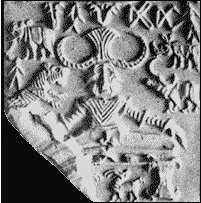The Indus River civilization was born by the mighty river, nestled between mountains and plains in what is now modern-day Pakistan, India and Afghanistan. This civilization flourished between 3300 BCE and 1600 BCE, represented by the large planned cities of Harappa and Mohenjo-Daro. This civilization may have been one of the first to domesticate sesame seeds, peas and dates. They had elaborate irrigation and sewer systems. The cities were laid out in grids, much like modern cities. They also developed a system of writing that to this day remains undeciphered.
The flooding of the Indus River and invasions from outsiders may have contributed to the decline of this civilization. Much of the area had been abandoned by 1600 BCE.
 |
| Indus Valley Seals Public Domain |
Hundreds of clay seals have been excavated from the area. These seals date from as late at 2500 BCE and demonstrate a sophisticated level of government in the Indus River valley. The small seals, carved in square or rectangular sheets of soft soapstone and then baked after carving, were probably used to mark goods in shipment and government edicts. This suggests that the Indus Valley Civilization was at the epicenter of a large trading network. Over 400 unique signs and symbols have been catalogued from these seals, but as of yet the script remains unreadable.
 |
| Pashupati Seal Public Domain |
Often adorned with animals and humanoid figures, it is believed these images may offer a glimpse of the early formation of the Hindu faith. This is particularly true of the "Pashupati Seal," discovered in 1928. The seal is made from soapstone and features a figure in a horned headdress surrounded by animals. Some archeologists recognized the similarity to the Hindu god, Shiva and labeled the seal as evidence of a "proto-Shiva" influence in ancient Mohenjo-Daro. Although the figure is most likely a deity, its relationship to Hinduism is hotly contested among scholars today.
 |
| Photo: Joe Ravi Wikipedia Commons CC-BY-SA 3.0 |
One of the most famous statues of the Indus River Valley was discovered in 1926 and has been dubbed "The Dancing Girl of Mohenjo-Daro." This statue is made from bronze and stands roughly 4 inches tall. This statue confirmed the fact that the inhabitants of the Indus Valley Civilization had knowledge of metal working. Not only that, this statue shows a sophisticated level of artistic aesthetics.
 |
| Photo: Mamoon Mengal Creative Commons |
Likewise, this statue, carved from soapstone dating to at least 2000 BCE, was found in 1927. The bearded figure most certainly represented an elite individual and has been dubbed a "priest-king," yet who this person was remains a mystery.
As does most of the history of the Indus Valley civilization.
Points to Remember
- The Indus Valley Civilization developed planned cities with sewers and public baths.
- Little art survives, but the terracotta figurines and small government seals suggest a high level of sophistication and trade
- The Indus Valley Civilization had a system of writing with over 400 characters, but that writing remains undeciphered
- The art and imagery point to the possible beginnings of the Hindu faith
Next Chapter: Ancient China
Updated: August 14, 2014
© 2014 Bruce Janu
Bell, Book & Camera Productions
Bell, Book & Camera Productions

